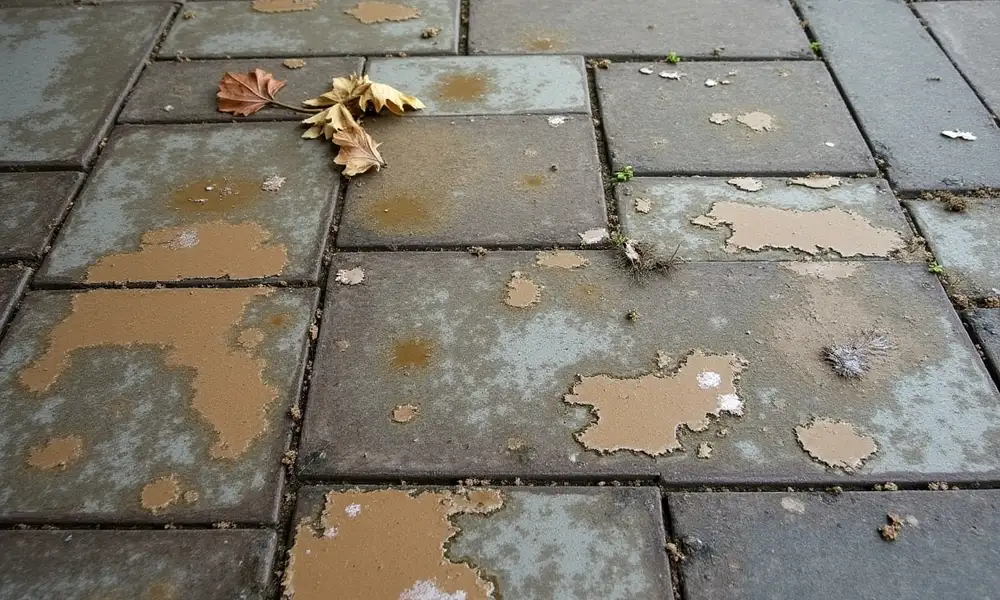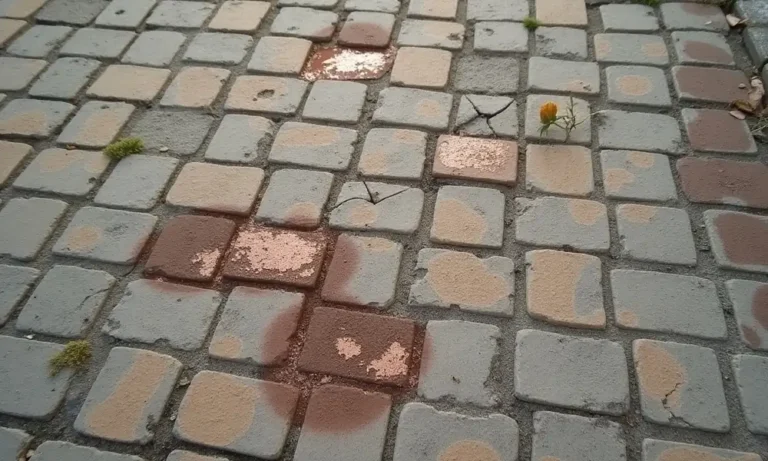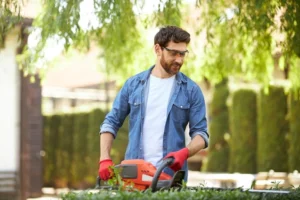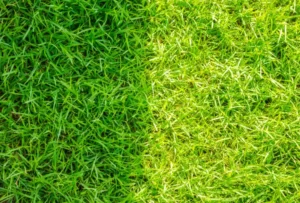How to remove oil stains from pavers is a common concern for homeowners and property managers alike. Oil stains are often caused by leaky vehicles, lawn equipment, or accidental spills, making them a frequent issue on driveways, patios, and walkways. These unsightly marks not only detract from the overall appearance of your outdoor space but can also lead to long-term damage if left untreated. Keeping your pavers clean is essential—not just for curb appeal, but also to extend their lifespan and prevent surface deterioration. Whether you’re trying to clean up oil stain on driveway surfaces or tackling the challenge of cleaning stained pavers, this guide will walk you through 6 easy steps to get the job done. Plus, we’ll share additional tips to make sure your pavers stay spotless and well-maintained.
Common Types of Stains on Paving Stones and How to Clean Them

Paving stones can enhance the look of any outdoor space, but over time, they’re prone to a variety of stains that can diminish their appearance. Knowing the type of stain and using the correct cleaning method is key to preserving the look and longevity of your paving stones.
1. Oil Stains
Motor oil and cooking oil are common culprits, especially on driveways and outdoor kitchens. These stains are difficult to remove because they might seep through the stone’s porous surface.
Tip for getting oil stains out of driveway: Use an absorbent material like cat litter to soak up fresh spills. For older stains, a degreasing agent or a specialized oil remover designed for paving stones works best.
2. Rust Stains
Water drainage from corroded fixtures or metal patio furniture and barbecues can cause rust.
Cleaning tip: Apply a rust remover that’s safe for use on stone surfaces—avoid acidic cleaners that may etch or discolor the stone.
3. Mold & Mildew
These produce unattractive green or black stains because they grow best in regions that are shaded or continuously moist.
Cleaning tip: Make use of a mold and mildew cleaning or a water and mild bleach solution. Use a brush to gently scrub, then rinse well.
4. Efflorescence
This white, chalky residue is caused by water-soluble salts rising to the surface.
Cleaning tip: A stiff brush and water can remove light deposits. For stubborn cases, use a commercial efflorescence cleaner specifically formulated for pavers.
5. Paint & Grease Stains
Paint drips or food grease from barbecues can leave noticeable marks.
Cleaning tip: Use a paint remover that won’t damage stone. For grease, a degreaser or poultice can draw out deep-set stains.
You can also read about paver installation in Bay Area.
Why Oil Stains Are Tough to Remove from Paving Stones
Oil stains are among the most stubborn and unsightly marks that can appear on paving stones, especially on driveways and outdoor cooking areas. The reason they’re so difficult to remove lies in the nature of both the oil and the paver surface.
Paving stones are naturally porous, meaning they have tiny holes and channels that can easily absorb liquids. Oil that spills doesn’t simply remain on the surface; instead, it penetrates deeply into these pores and forms a bond with the stone beneath the top layer.
It becomes more difficult to remove using conventional cleaning techniques the longer the oil remains since it penetrates and solidifies more. Over time, the stain can darken and spread, especially in warmer weather, where heat can cause the oil to flow further into the stone.
This is why getting oil stains out of driveway pavers requires prompt attention and often a combination of absorbents and heavy-duty degreasers. Acting quickly and using the right cleaning products can make a significant difference in how effectively the stain is removed.
How to Remove Oil Stains from Pavers in 6 Easy Steps

Oil spills on pavers—whether from leaky vehicles, grills, or outdoor equipment—can leave unsightly stains that are difficult to ignore. Because paving stones are porous, oil can seep in quickly and become tough to lift. Here’s how to remove oil stains from driveways, clean up road surfaces, and maintain the finest possible appearance for your outdoor spaces.
Step 1: Blot Up Excess Oil
If the oil spill is fresh, act immediately. Use paper towels, an old rag, or even sawdust or kitty litter to absorb as much oil as possible before it penetrates the surface. Gently press down; avoid rubbing as this may cause the discoloration to spread. Quick action here makes the rest of the cleaning process far easier.
Step 2: Apply an Absorbent Cleaning Agent
Once you’ve blotted up the excess oil, cover the stained area with an absorbent powder such as baking soda, cornstarch, or a commercial oil stain remover. These materials help draw out the oil from the small pores in the paver. For commercial cleaners, make sure the product is specifically formulated to remove oil stains from driveway or stone surfaces.
Step 3: Scrub the Area Gently
Using a stiff (but non-metal) brush, gently scrub the cleaning agent into the surface. The goal is to push the cleaner into the pores of the paver without damaging it. If you’re cleaning stained pavers made of concrete or natural stone, avoid wire brushes, which can cause scratches.
Step 4: Let It Sit
Let the cleaning agent sit on the stain for 15 to 30 minutes—longer for older or deeper stains. This dwell time allows the cleaner to break down and absorb the embedded oil. For stubborn stains, some commercial removers may recommend leaving the product overnight—check the label instructions.
Step 5: Rinse Thoroughly
Use a garden hose with a spray nozzle to rinse the area thoroughly. If needed, a pressure washer on a low to medium setting can help remove any lingering residue—but be cautious not to blast away the joint sand between pavers or damage the surface. This step is essential when you’re trying to clean up oil stain on driveway areas with heavy accumulation.
Step 6: Repeat if Necessary
Some stains—especially old or untreated ones—may require multiple treatments. Don’t be discouraged. Reapply your chosen cleaner or try a stronger solution until the stain fades. Patience and repetition are key to fully remove oil stains from driveway surfaces.
You can also read about Five Reasons to Hire a Paver Installation Professional.
Additional Tips for Cleaning Pavers

Keeping your pavers looking their best doesn’t stop at stain removal. Regular care and smart preventative measures can go a long way in preserving their appearance and durability. Here are some essential tips for cleaning stained pavers and maintaining them over time:
1. Seal Your Pavers
Applying a high-quality paver sealer creates a protective barrier that helps repel oil, grease, water, and other contaminants. Sealing makes future cleaning easier and prevents deep stains from setting in. It’s especially recommended after you remove driveway oil stains, as it reduces the risk of recurrence.
2. Avoid Harsh Chemicals
Stay away from strong acids, bleach, or ammonia-based cleaners unless specifically designed for use on stone or concrete. Harsh chemicals can etch, discolor, or weaken the surface of your pavers, especially natural stone. Always opt for paver-safe or pH-neutral cleaning solutions.
3. Perform Regular Maintenance Cleaning
Routine sweeping and occasional rinsing with water can prevent dirt and debris from building up. For deeper maintenance, use a mild detergent and water to keep your pavers clean and free from stains before they become deeply embedded.
4. Test New Products First
Before using any new cleaning product, always test it on a small, hidden area of your pavers. This ensures the cleaner won’t cause discoloration or damage. It’s a small step that can save you from costly mistakes.
When to Call a Professional
If you’re dealing with large, stubborn, or deeply embedded oil stains, or if your pavers are made from delicate or high-end materials, it may be time to call in the experts. DIY methods can only go so far—and using the wrong cleaner can cause costly damage. Need help restoring your driveway or patio? Contact us for professional paver cleaning and care. Let us handle the hard work and bring your surfaces back to life!
FAQs
1. What Is The Best Way To Remove Oil Stains From Pavers?
The most effective method combines blotting fresh oil, applying an absorbent agent like baking soda or a commercial oil remover, gentle scrubbing with a brush, and rinsing thoroughly. You may need to repeat the process for older stains.
2. Can I Use Household Items To Clean Oil Stains On Pavers?
Yes. Common items like baking soda, dish soap, cornstarch, and even kitty litter can help clean up oil stain on driveway surfaces if the stain is fresh. For deeper stains, a commercial degreaser may be necessary.
3. Will Pressure Washing Remove Driveway Oil Stains Completely?
Pressure washing can help, especially in combination with a cleaning agent. However, it may not fully remove driveway oil stains that have soaked deep into porous pavers. Always use a pressure washer with care to avoid surface damage.
4. Are Oil Stains Permanent On Pavers?
Not necessarily. While they can be difficult to remove if left untreated, most oil stains can be lifted with repeated cleaning and the right products. Sealing your pavers afterward can prevent future staining.
5. How Soon Should I Treat An Oil Stain On Pavers?
Immediately. The longer oil sits on the paver surface, the deeper it seeps in and the harder it becomes to remove. Quick action is key to successful stain removal.





